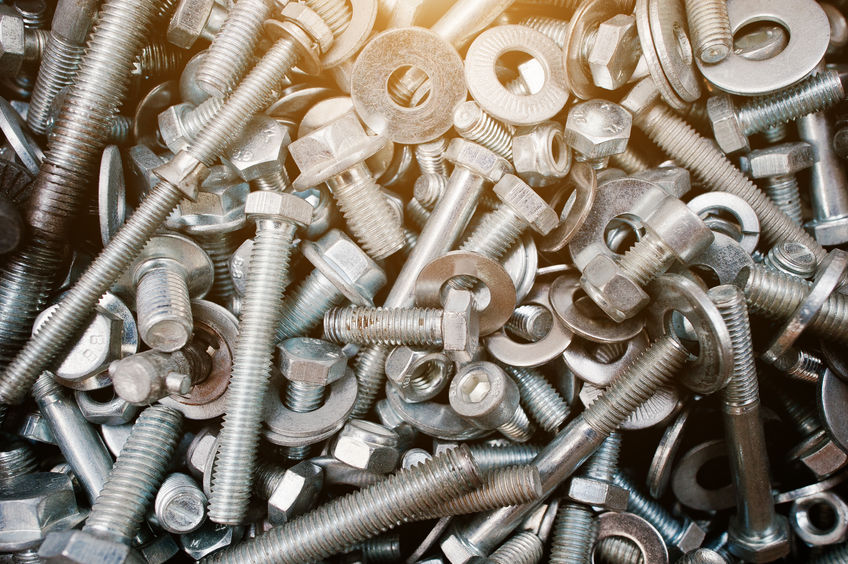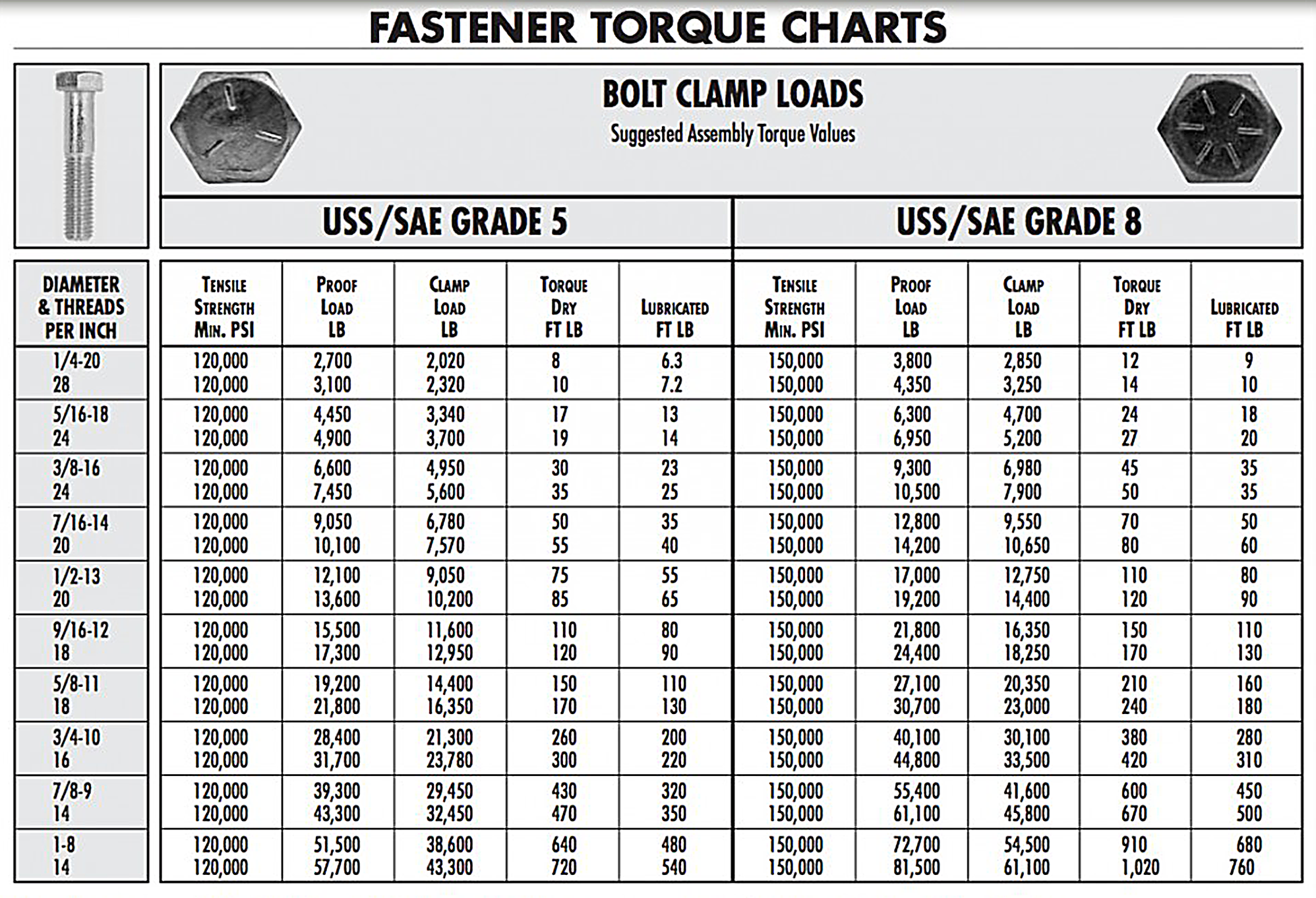
Q.
I am working on a resto-mod of a 1955 Chevy Belair. I’ve never done it before, so every step of this is new to me. I am using grades 5 and 8 throughout, but have found that no one includes torque specifications with their aftermarket kits.When it comes to properly torquing brake, steering, and drive shaft components, I want to make sure I do not exceed the torque value/rating for the bolts. When I contact kit providers, the advice I get to just make it “tight” or “hang on the torque wrench” is a little too vague for me when safety is top priority.
I have studied several torque charts and no two are even close to showing the same value for the same bolt. If they where close, I would feel comfortable with backing off the torque value by 1-2% from the max stated value and call it quits, but I could never do this.
What do you suggest I do to get closer to the specific max torque value of any bolt grade, size, thread etc.?
A.
There is no shortage of experts when it comes to measuring and determining proper bolt torque, but there are many considerations here as well.Bolt torque measures the tensile load on the bolt. It is important to recognize that not all bolt torque situations require the bolt to be brought to it’s max torque, In fact in some situations, larger bolts are used to increase shear strength as opposed to tensile strength.
I’ve included a torque chart I commonly use, but keep in mind not every bolt on a car should be brought to maximum torque. For example, items like gas tank straps just need to be tight, as over-tightening them could result in damage to the tank or straps.
All brake kits I have installed included the manufactures bolt torque specs. I would guess that’s a liability issue the manufacture just does not want to deal with. Driveshaft U-bolts do have torque specs, and here are some common driveshaft component torque specs as listed by Dana Spicer Corporation.
U-BOLTS
Recommended Torque to Tighten Correctly1310 Series 14 to 17 Lb. Ft.
1330 Series 14 to 17 Lb. Ft.
1350 Series 20 to 24 Lb. Ft.
1410 Series 20 to 24 Lb. Ft.
STRAPS & BOLTS
Recommended Torque to Tighten Correctly1310 Series Dana Spicer Yokes 13 to 18 Lb. Ft.
1330 Series Dana Spicer Yokes 13 to 18 Lb. Ft.
GM Yokes 3R Series 30 to 35 Lb. Ft.
GM Yokes 1310 Series long bolts 30 to 35 Lb. Ft.
GM Yokes 1330 Series long bolts 30 to 35 Lb. Ft.
GM Yokes 1350 Series long bolts 30 to 35 Lb. Ft.
1350 Series Dana Spicer Yokes 30 to 35 Lb. Ft.
1350 Series Corvette Metric Bolts 25 to 30 Lb. Ft.
1410 Series Dana Spicer Yokes 30 to 35 Lb. Ft.
7260 Dodge 13 to 18 Lb. Ft.
7290 Dodge 13 to 18 Lb. Ft.
I am a little unclear as to what steering components you’re looking for torque specs on, but this information might be helpful. Set screws for U-Joints are usually brought to “tight,” as these are small diameter screws that are held in place with a jam nut.
(Note: It is always necessary to dimple steering shafts beneath set-screws so joints are not allowed to slide off shafts even in a slightly loose configuration.)
I hope this helps!
Wrench safe, Mark

Great info Mark. Really nice you provided a chart. I know it sounds a little to simple but with some of the people just getting their feet wet with this stuff I would humbly include that the size of the bolt is the shaft size not the head size. Super advise you gave.
There is also another factor to take into consideration when torquing bolts-Are the threads lubricated or not? A lubricated thread will apply more pressure than a non-lubricated one, and it will achieve a greater stretch at the same torque due to the lubricity. This can lead to over-torquing of a bolt, typically a lubricated thread will be torqued to around 60% of a dry thread (40% reduction for lubricated threads).
There is a company in Houston called “The Nut Place “they will custom make or have any bolt or screw u are looking for along with spec’s
As an example a good book that can help with the torque specs for various bolts with and without lubrication and when to go dry or to lubricate (a change as great as 40% depending on application) and many other useful information is AUDEL Mechanical Trades Pocket Manual, I have the fourth edition but that's about 15 years old. As with anything following manufactures specs are the best regarding bolt strength, metallurgy and related hardware. In addition a well maintained and calibrated torque wrench ranged about midway for he measurement will give the best results.
thanks I needed this.
Torque specs are great if you can find the proper bolts for a given application. Where can one find charts on which bolt to use especially on frames and braces?
The specs quoted above assume that this is a clamping force that mates a #8 nut to a Number 8 Bolt. If you are fastening these into tapped holes in heads, blocks etc., the number 8 bolt could pull the threads right out of the threaded hole. I suggest that the safest spec is to follow the original torque spec in the manufacturer's manual.
Grade 8 bolts are not a cure all. They very strong in a tensile application but are also much more brittle that Grade 3 bolts. If a bolt is in a shear application that receives an impact this can be a problem. A Grade 3 bolt will distort but will not just break off like a Grade 8 bolt.